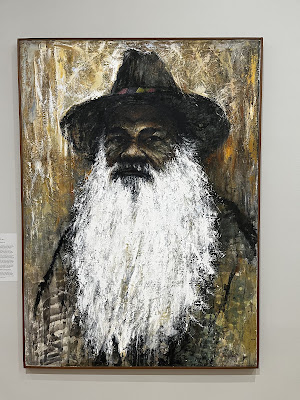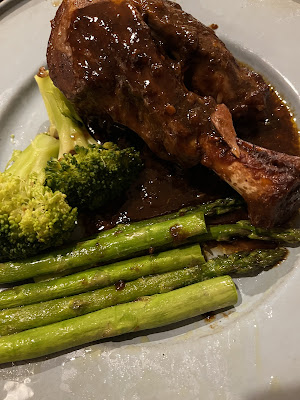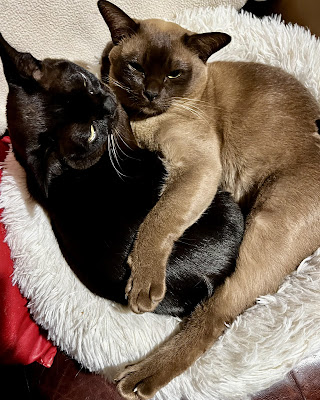Love Letters opens next week - we are working on the detail: of the set, the props, the lights, the delivery of certain lines, the timing of the music.
 |
| Michael Sparks as Andy and Andrea Close as Melissa in rehearsal for Love Letters |
After long days of work and rehearsals, I had a night off, in which Him Outdoors made me lamb shanks and green veg for dinner. I know the meat came in a pre-cooked packet from the supermarket, but it was still a great treat, and the kittens shared the evening in too.
I have been preparing a workshop for my team to come to Canberra. As part of the two-day event I ran a session on our organisation's values and what they meant to us as individuals and a team. As part of that session, I took them to the National Portrait Gallery where we all chose an artwork of a person who we felt represented those values, and shared our findings with the group. I walked around the gallery and picked some of my favourites.
 |
| Dr Brown and Green Old Time Waltz (1983) by Harold Thornton |
Bob Brown, environmental activist, was the first Parliamentary Leader of the Australian Greens. Brown studied medicine at the University of Sydney before moving to Tasmania and working as a general practitioner in Launceston. In 1976, having taken a rafting trip down the Franklin River, he became a founding member of the Wilderness Society. From then until 1983 he led the campaign against proposed dam works on the Franklin, which was subsequently preserved with a World Heritage Listing. n 1983, he began a decade in the Tasmanian House of Assembly as the member for Denison. He was elected to the Federal Senate as a member of the Tasmanian Greens in 1996 and later co-founded the Australian Greens, which he guided from a fringe to a mainstream political force before resigning from the leadership in 2012. That year he established the Bob Brown Foundation, a not-for-profit organisation supporting environmental causes.
Harold Thornton travelled to Tasmania in December 1982 to join Brown and the 6,000 protestors blocking the construction of the Franklin Dam. Thornton painted this portrait of Brown while he was in the wilderness campsite and in his Hobart and Sydney studios. Despite its fanciful elements, this painting provides a faithful record of the Franklin blockade. It was a finalist for the 1983 Archibald Prize.
 |
| Patrick Dodson (2004) by Zhou Xiaoping |
Patrick Dodson, senator for Western Australia, is a Yawuru man who was born in Broome but spent most of his childhood in the Northern Territory. Orphaned in 1960, in 1961 he was sent (with his brother, Mick) to Monivale College in Victoria. In 1975 he became Australia's first Aboriginal Catholic priest, but left the priesthood in the early 1980s. As director of the Central Land Council, he was integral to negotiations for the return of the Uluru Kata- Tjuta National Park to traditional owners in 1985. In 1989 he was a commissioner of the Royal Commission into Aboriginal Deaths in Custody, and in 1991 he became the first chairperson of the Council for Aboriginal Reconciliation. From 2012 to 2012 Dodson co-chaired the expert panel on the constitutional recognition of Aboriginal and Torres Strait Islander peoples. He was the inaugural director of the Indigenous Policy, Dialogue and Research Unit at the University of New South Wales and is the first Indigenous Australian to be appointed to the council of the Australian National University.
Zhou Xiaoping met Dodson in 2002 at the funeral for artists Jimmy Pike, whose widow helped arrange a portrait sitting. "We spent half a day together and I did a number of sketches of him , painting with Chinese ink and brushes on large rice paper,' Zhou says. Back in Melbourne, he mounted the painting on canvas and later added a layer of acrylic and oil paint.
 |
| Charles Teo (2011) by Adam Chang |
Charles Teo AM is a neurosurgeon. Born in Sydney (1975), he graduated in medicine and surgery from the University of New South Wales and worked in the USA at the Children's Medical Centre, Dallas and at the University of Arkansas. After returning home he worked at Sydney's Prince of Wales Private Hospital, establishing a reputation in the field of minimally-invasive neurosurgery and becoming known for performing radical surgery on tumours other surgeons considered inoperable. While some of his patients think him a miracle worker, Teo's approach has attracted condemnation within the medical profession, resulting in recent investigations by the NSW Medical Council and the Health Care Complaints Commission. Teo has been a visiting professor at more than 50 universities and hospitals worldwide, and the Cure for Life Foundation, which he formed in 2003, is the leading founder of brain cancer research in Australia.
Adam Change (Hong Jun Zhang), born in Shanghai, migrated to Australia in 1997 and has been an Archibald Prize finalist six times. In 2011 the animal-protection organisation Voiceless staged a fundraising event in which participants could win a commissioned portrait by Chang. Published Eleonora Triguboff won the prize and initiated this portrait of Charles Teo, who served on the Voiceless council from 2009 to 2015.
 |
| Fred Hollows (1993) by Kerrie Lester |
After completing his specialist training in England and Wales, in 1965 Professor Fred Hollows AC became Associate Professor of Ophthalmology at the University of New South Wales. Soon afterwards he began investigating eye disease in Aboriginal communities. Throughout the 1970s and 1980s he pioneered treatments of trachoma and other eye diseases that have halved the incidence of curable blindness in Aboriginal populations. He also established successful eye treatment schemes overseas, notably in Nepal and Eritrea. The gruff doctor was Australian of the Year in 1990 and was accorded a State funeral following his death from cancer three years later. The Fred Hollows Foundation continues his work, spearheaded by his widow, Gabi Hollows.
Kerrie Lester's bold and distinctive portraits, in which the outlines of the sitters are hand-stitched, were contenders for the Archibald Prize at least sixteen times. This portrait of Hollows was made when he was dying. In a 2013 Derivan artist talk, Lester said, 'He always had a pipe hanging out the corner of his mouth. I like to paint beyond what I see of the person, their mannerisms and the way they stand and the way they hold their head and the way they move.'
 |
| Cathy Freeman (1999) by Kerrie Lester |
Cathy Freeman OAM won the 400m Olympic Gold medal in front of her home crowd in Sydney 2000, famously carrying both the Australian and the Aboriginal flags on her victory lap. Born in Mackay, Queensland, her mother is of the Kuk Yalanji people and her father was of the Burri Gubba people. Aged sixteen, Freeman was selected for the Australian women's 4 x 100m relay team that won the gold medal at the Commonwealth Games in Auckland. She won two more gold medals at the Commonwealth Games in Canada in 1994 with victories in the 200m and 400m. The first Aboriginal track and field athlete to represent Australia at the Olympic Games, she won a silver medal in the 400m in Atlanta in 1996. She was ranked first in the world in her signature event, in which she won back-to-back World Championships in 1997 and 1999. After her retirement in 2003, she established the Cathy Freeman Foundation, which continues to enhance educational opportunities for Aboriginal and Torres Strait Islander children in remote communities.
Known for her playful, textured, highly-coloured works, Kerrie Lester's style is well suited to the unpretentious personality of her powerful sitter. Lester worked on the portrait during breaks in Freeman's training schedule prior to the Sydney Olympics.
I then took my team to the top of Mt Ainslie to show them the view of Canberra below. I extended a metaphor about seeing the big picture and gaining new perspective from regarding things from a different aspect. It was also a good excuse to get out into the fresh air.
 |
| Work team at Mt Ainslie |
We were busy at the weekend - rehearsals and such - and I was quite exhausted so there was no time to go far afield for my trig bagging. Fortunately, we have Mt Painter practically on our doorstep so we went for a walk up there before breakfast.








No comments:
Post a Comment